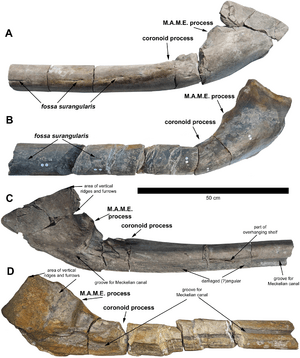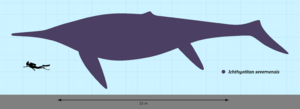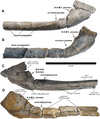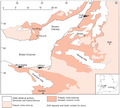Ichthyotitan facts for kids
Quick facts for kids Ichthyotitan |
|
|---|---|
 |
|
| Holotype (A, C) and referred (B, D) specimens of Ichthyotitan | |
| Scientific classification | |
| Genus: |
Ichthyotitan
|
| Species: |
severnensis
|
Ichthyotitan (say: Ik-thee-oh-TY-tan) is an extinct (no longer living) type of giant ichthyosaur. Ichthyosaurs were large marine reptiles that looked a bit like dolphins or fish. This amazing creature lived during the Late Triassic period, about 205 to 202 million years ago. Its fossils were found in the Westbury Mudstone Formation in Somerset, United Kingdom.
Scientists believe Ichthyotitan was a shastasaurid, a group of very large ichthyosaurs. Its discovery shows that these huge marine reptiles were still thriving right up until the Triassic–Jurassic extinction event. This was a big event that caused many species to disappear.
The genus Ichthyotitan has only one known species, called I. severnensis. We know about it from two pieces of its lower jawbone, called surangular bones. These were found in different places in 2016 and 2020. Scientists have also found other bone pieces in Western Europe that might belong to Ichthyotitan. By comparing its bones to other ichthyosaurs, experts think Ichthyotitan could have been about 25 meters (82 feet) long. This would make it the largest marine reptile ever discovered!
Contents
Discovering a Giant
The story of Ichthyotitan's discovery is quite exciting. It involves both experienced fossil hunters and a young girl!
The Lilstock Bone
The first piece of Ichthyotitan was found in 2016. A fossil collector named Paul de la Salle discovered it in the Westbury Formation. This bone was a part of the left lower jaw, about 96 centimeters (3.1 feet) long. It's now kept at the Bristol Museum & Art Gallery.
In 2018, a team of researchers, including Dean Lomax and Paul de la Salle, studied this bone. They realized it belonged to a shastasaurid. This discovery also made them wonder if other large bones found nearby, which were thought to be from land reptiles, might actually be from giant ichthyosaurs.
The Main Discovery
The most important Ichthyotitan fossil, called the holotype, was found in 2020. It was discovered near Blue Anchor in Somerset, UK. The first fragment was found by 11-year-old Ruby Reynolds. She was looking for fossils on the beach with her father, Justin Reynolds.
They contacted researcher Dean Lomax, who then reached out to Paul de la Salle. The team went on more expeditions until October 2022. They found more pieces of the jawbone and put them together in 2022. Even though it's not a complete jaw, this piece alone was estimated to be over 2 meters (6.6 feet) long!
Scientists could tell that this animal was still growing when it died. This means it was either a young adult or a subadult. The bone also had signs of sea creatures growing on it. There were even possible signs that other animals had tried to eat it after it died. This amazing fossil is planned to be shown at the Bristol Museum and Art Gallery.
In 2024, Dean Lomax and his team officially described Ichthyotitan severnensis. They named it as a new genus and species based on these two important jawbones.
What Does the Name Mean?
The name Ichthyotitan is a mix of Greek words. "Ichthys" means "fish" and "sauros" means "lizard." So, "Ichthyosaurus" means "fish lizard." The "titan" part means "giant." Put it all together, and Ichthyotitan means "giant fish lizard"!
The second part of its name, severnensis, refers to the Severn Estuary. This is a large river mouth near where the main fossil was found.
Other Possible Bones
Scientists have also found other bone fragments in Germany and France. These bones are from giant ichthyosaurs of a similar age to Ichthyotitan. This suggests that these huge marine reptiles might have lived in many parts of Europe.
How Big Was It?
Because the fossils are not complete, it's hard to know the exact size of Ichthyotitan. But it was definitely enormous!
Scientists compared the Ichthyotitan jawbone to the same bone in another giant ichthyosaur, Shastasaurus sikanniensis. They estimated that Ichthyotitan could have been around 26 meters (85 feet) long. This is almost as big as a blue whale, the largest animal on Earth today!
Another way to estimate its size gave a slightly shorter length of about 22 meters (72 feet). In 2024, after more study, scientists gave a revised estimate of about 25 meters (82 feet). This makes Ichthyotitan likely the largest marine reptile ever found.
What Did It Eat?
Scientists used to think that shastasaurids like Ichthyotitan sucked in their food. But newer research suggests this is not true. Their jaw bones were not built for suction feeding. Also, some shastasaurids had strong teeth and ate things like mollusk shells and other vertebrates.
Ichthyotitan was likely a predator. This means it hunted smaller prey, possibly even other marine reptiles. It might have hunted in a way similar to an orca (killer whale). This suggests that the ocean food webs during the Triassic period were very rich. It also shows that shastasaurids were doing well before they disappeared in the end-Triassic extinction event.
The fact that some Ichthyotitan fossils show signs of being eaten by scavengers before burial helps explain why we don't find many of their fossils.
Images for kids
-
Places where Ichthyotitan bones have been found around the Bristol Channel and Severn Estuary.
See also
 In Spanish: Ichthyotitan severnensis para niños
In Spanish: Ichthyotitan severnensis para niños





